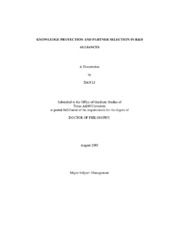| dc.description.abstract | This dissertation investigates three sets of research questions. First, how can partner selection be used as a mechanism to minimize R&D alliance participants’ concerns about knowledge leakage? And what is the nature of the relationship among partner selection and two previously-studied protection mechanisms – governance structure and alliance scope? Extending this research question to the international context, the second set of research questions asks how international R&D alliances differ from their domestic counterparts in partner selection to protect their participants’ valuable knowledge, and how different types of international R&D alliances vary in this regard. Distinguishing bilateral from multilateral R&D alliances, this dissertation examines a third set of questions about how multilateral R&D alliances differ from bilateral ones in partner selection for the purpose of protecting participants’ technological assets. Hypotheses are proposed and tested with a sample of 2,185 R&D alliances involving companies in high technology industries. Results indicate that the more radical the innovation an R&D alliance intends to develop, the more likely the alliance will be formed between Friends than Strangers. However, under the same situation, firms are less likely to select Acquaintances than Strangers. A substitution effect was detected among partner selection, governance structure, and alliance scope used by firms to protect their valuable technological assets from being appropriated in R&D alliances. In addition, no empirical support was found for different partner selection preferences for firms forming domestic R&D alliances versus international R&D alliances. However, results show that firms, when forming trinational R&D alliances and/or traditional international R&D alliances, are more likely to select their prior partners than when forming cross-nation domestic R&D alliances. Moreover, this study shows that when an R&D alliance is formed by multiple companies, partner firms are more likely to be prior partners. I argue that concerns about knowledge leakage explain this result. | en |


